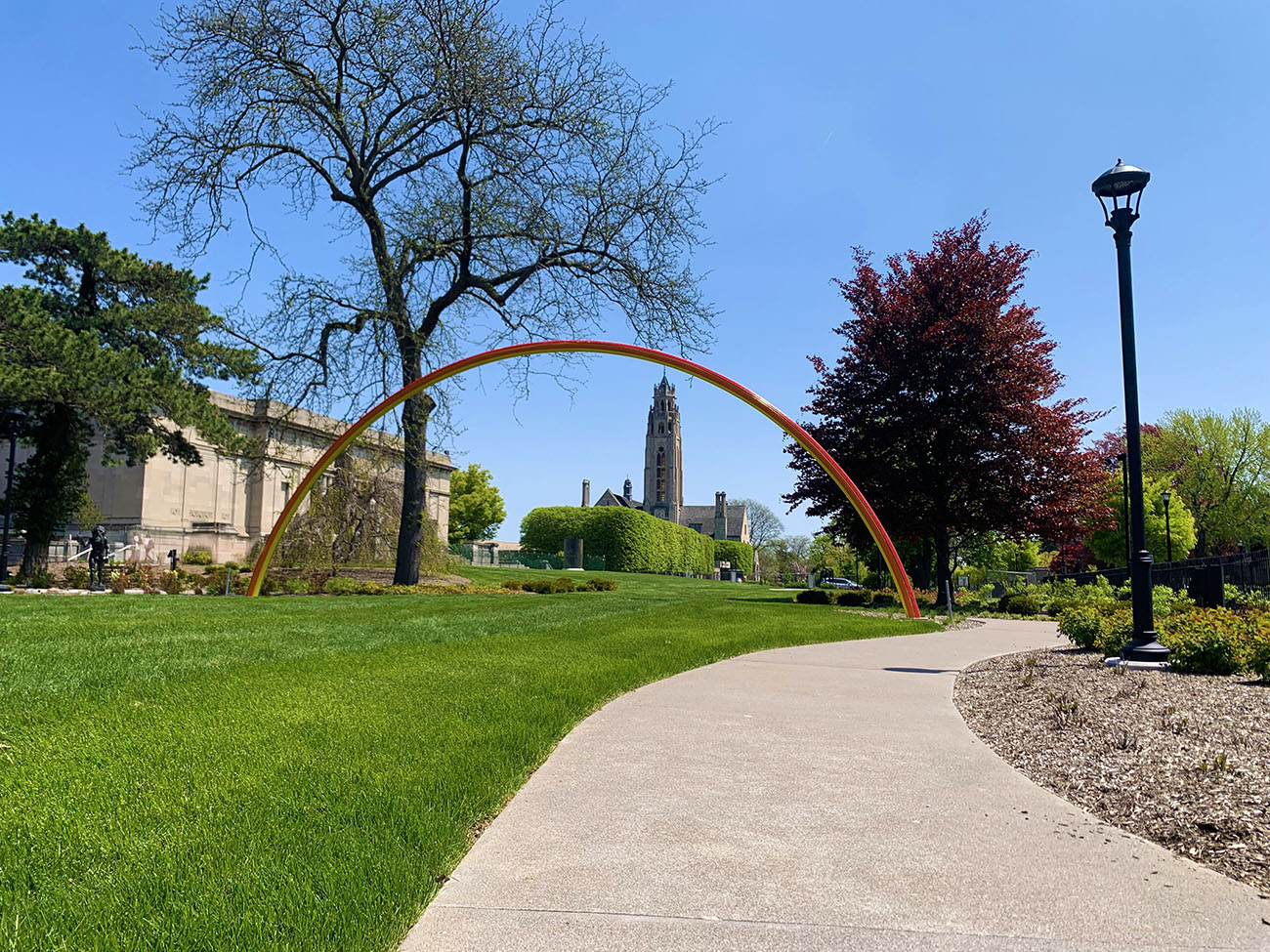MAG’s Centennial Sculpture Park is an artistic urban oasis for the city of Rochester that is always open and always free. In the spirit of inspiring fun, which is fundamental to MAG’s mission, these works of art are playful, flexible, smart, and provocative. MAG opened the park in 2013 to celebrate our centennial, recasting ten acres of the Gallery’s grounds into a showcase of public art and urban space.
Digital Guide
Explore MAG’s grounds—from the works in the Centennial Sculpture Park to the Poets and Story Walks, interactive installations that run along the University Avenue and North Goodman Street sidewalks and honor poets and local authors as artists of the written word—in our digital guide!
History of the Park
Planning Phase I: 2008-2012
In 2008, mindful of its 2013 Centennial, the Gallery initiated a master planning process for its grounds to extend its mission, “Connecting People with Art,” to include great works of art inside and out. In response to many voices from the community, the plan included the removal of sections of the University and Goodman Street fence line to extend a clear welcome message to the community.
During this time, MAG’s Board of Managers launched a capital and endowment campaign: “Gateways to Art: Memorial Art Gallery’s Next 100 Years.” Planned with a significant capital campaign for the University of Rochester, the Gallery’s campaign objectives included several major initiatives, including the opportunity to create the Centennial Sculpture Park. MAG raised $4.3 million for Phase I through its Gateways to Art campaign in conjunction with the museum’s centennial. (Gateways to Art co-chairs: Charlotte Herrera and Andy Gallina).
The City of Rochester was awarded a highly competitive, $250,000 Mayor’s Institute on City Design grant from the National Endowment for the Arts. The grant supported the expansion of ARTWalk, an innovative urban art trail in Rochester’s Neighborhood of the Arts. The City was joined by twelve community partners, including the Memorial Art Gallery, whose planned Centennial Sculpture Park was one of the anchors of the ARTWalk Extension Project.
“The NEA grant underscores the significance of the ARTWalk project for this entire community,” said past MAG director Grant Holcomb. “In partnership with the City of Rochester and various community organizations, the Memorial Art Gallery of the University of Rochester looks forward to playing a key role in revitalizing this area. Specifically, the development of the Gallery’s Centennial Sculpture Park will transform University Avenue and, in so doing, help create a significant ‘cultural destination’ in Rochester.”
The Gallery also benefits from other project components, including a Poet’s Walk and Story Walk planned and curated by Writers & Books and media sponsor the Democrat and Chronicle. Poet’s Walk and Story Walk draw on contributions by area residents, among them several nationally renowned poets, and will be accessible by mobile and internet.
These two interactive “art walks” connect people to the museum’s main entrance and Rochester’s history and rich creative community. On “Poet’s Walk,” which follows University Avenue, visitors can access poems by historical and contemporary poets with ties to Rochester via their phones. A similar feature is available on “Story Walk” on Goodman Street, where visitors can listen to stories with specific connections to Rochester’s history.
Four major artists were commissioned in Phase I to create work for Centennial Sculpture Park. Tom Otterness, known internationally for his engaging installations, created two heroic figures for the corner of Goodman and University. He depicted a female sculptor carving a male figure from a block of stone – which takes you on a path through the trees to a stone quarry where her previous attempts lie scattered. Jackie Ferrara, whose geometric pathways are included in sculpture parks and landscapes around the country, designed the path leading from the ‘quarry’ area to the front entrance of MAG. Rochester’s Wendell Castle’s Unicorn Family provided an outdoor and whimsical cast iron grouping of chairs, a table, and a lamp for the community and visitors who want to enjoy the passing scene. Also based in Rochester, Albert Paley contributed Soliloquy, a monumental 25-foot stainless steel sculpture to mark the Goodman Street entrance.
“The Paley Commission completes our vision of four new works by internationally acclaimed artists for the Centennial Sculpture Park,” said director Grant Holcomb. “Best of all, two of the four are Rochester’s.”
Installation of these sculptures began in the summer of 2011, with completion in spring of 2012. The work, which is MAG’s largest art acquisition ever, was underwritten by the Gallery’s Maurice R. and Maxine B. Forman Fund for art acquisition. The strategic location of Centennial Sculpture Park, along with the removal of portions of decades-old wrought-iron fencing, has made the Gallery a more vital part of the neighborhood, opening up the grounds for the public to enjoy and attract tourism.
In 2013, a dedication and ribbon cutting took place, bringing the Memorial Art Gallery’s Centennial Sculpture Park one step closer to completion.
Since then, the community has enjoyed all the Sculpture Park offers, with live music at the annual M&T Bank Clothesline Festival, dance performances on Celebration Days, outdoor yoga classes, and summer camp activities.
Planning Phase II: 2013-2023
In 2014, a new Mary W. and Donald R. Clark Director, Jonathan P. Binstock, arrived at MAG with a vision for Phase II of the park: to transform the remaining two acres of open lawn along University Avenue by adding several sculptures, including many significant new acquisitions. Phase II extended the Sculpture Park to Prince Street, adding another entrance to the grounds near the School of the Arts (SOTA). The entrance at the corner of University Avenue and Prince Street is flanked by iron gates original to the museum. MAG hired Bayer Landscape Architecture, PLLC, during this phase to design the park. In 2021, the fencing surrounding the remainder of MAG came down, and a groundbreaking ceremony was held.
A curatorial focus was for the expansion to be playful, smart, and colorful approaches to art that will draw people to the grounds. MAG chose for its permanent collection a piece by Pia Camil, a Mexican artist, and it commissioned work from Rashid Johnson, an African American artist who is one of the most influential voices of his generation.
SOTA students were the inspiration for the commissioned Rashid Johnson Community Pavilion. When Johnson visited MAG to explore ideas for a new work of art, he was drawn to the Black and Brown students mingling on Prince Street. Johnson asked MAG staff if SOTA’s students visited the museum. He was told they did, but the museum would like them to come more often. Johnson decided to design a work with these students in mind that would also invite and serve the community.
Johnson is a powerfully expressive artist, which is evident in this sculpture measuring 10 feet tall at its highest point by about 40 feet in diameter. Visitors feel the welcoming nature of the sculpture’s curved form, which effectively embraces all who approach it. The interior of the work features a built-in audience made up of nongendered, non-raced faces—an audience that represents everyone and anyone. Johnson wants this to be a place where SOTA’s developing artists and all community members can hone their craft—to practice their lines, recite poetry, sing a song, or play music.
The convex side incorporates standing, totemic figures that welcome all to join them from across the street—from SOTA and the streets around and beyond. Johnson calls these figures and faces “broken and anxious.” For him, they reflect a condition of modern life. He wants everyone to see themselves here—and to find strength in the fact that everyone must confront the challenges and stressors of living in today’s world.

The culmination of donations, grants, and gifts led to the official opening of the Centennial Sculpture Park on Sunday, June 4, 2023. The completion of Phase II was marked with a ribbon-cutting ceremony and Celebration Day and the establishment of a $1.2M endowment that will provide care for the park in perpetuity. In November 2022, the Sands Family Supporting Foundation, Inc., Constellation Brands, and Abby and Doug Bennett announced a challenge to the community to support MAG’s Centennial Sculpture Park. Once MAG secured $500,000 in gifts and pledges, the donors generously matched the community’s support with another $500,000. With this, the Rashid Johnson Community Pavilion was officially named. MAG supporters generously contributed to reach the challenge and exceed it by more than $280K, fully funding the Centennial Sculpture Park endowment.
Bayer Landscape Architecture, PLLC, is responsible for the Centennial Sculpture Park master site planning and design.
The Memorial Art Gallery’s centennial year was presented by Lynne Lovejoy, with additional support from Robert L. and Mary L. Sproull, ESL Charitable Foundation and Nocon & Associates, a private wealth advisory practice of Ameriprise Financial Services, Inc.
Phase II of Centennial Sculpture Park was made possible by lead gifts from the Estate of Elizabeth Plumb Miller, Nancy B. Miller, Sands Family Supporting Foundation, Inc., Sandra Hawks Lloyd and Justin Hawks Lloyd, Douglas S. and Abigail J. Bennett, Constellation Brands, Inc., Gallery Council of the Memorial Art Gallery, the Gallina Family, Gwen M. Greene in memory of John D. Greene, and Kathleen M. Landers and Peter J. Landers.
State support was provided by Empire State Development and New York State Council on the Arts with the support of the Office of the Governor and the New York State Legislature.
For a full list of sponsors, click here.

